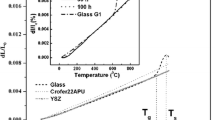Abstract
This work aimed to analyze the glass material used for sealing the end of a thermal collector in a parabolic trough solar power plant. Based on matched sealing requirements and application performance of glass and Kovar alloy 4J29, one borosilicate glass material (GD480S), whose expansion coefficient was similar to that of Kovar alloy 4J29, was studied. Moreover, the effect of the ratio of SiO2 to B2O3 on the glass properties was explored in detail by Fourier transform infrared spectroscopy. As the SiO2 to B2O3 ratio in the glass increased from 4.18 to 5.77, the expansion coefficient showed a decreasing trend from 4.95×10−6/°C to 4.55×10−6/°C. In addition, the water resistance performance improved, enabling the glass material to seal well with the alloy for application in a trough solar power plant. Thus, the increase in the SiO2 to B2O3 ratio made the glass structure more compact and improved the glass performance to meet the requirements of an industrial tubular receiver.
Similar content being viewed by others
References
Fernandez G A, Zarza E, Valenzuela L, et al. Parabolic-trough Solar Collectors and Their Applications [J]. Renewable and Sustainable Energy Reviews, 2010, 14(7): 1 695–1 721
Li H P. Accelerating the Development of Solar Thermal Power Generation Technology [J]. High-Technology & Industrialization, 2008, 11: 27–30
Wu J F, Fang B Z, Xu X H, et al. Study on Thermal Shock Resistance of Al2O3-ZrO2 Thermal Storage Ceramics for Solar Thermal Power Generation[J]. Journal of Wuhan University of Technology, 2013, 35(1): 7–12
Mirunalini T, Hamzawy E M A. A Review of Solar Thermal Technologies[J]. Renewable and Sustainable Energy Reviews, 2010, 14: 312–322
Pask J A. From Technology to the Science of Glass/Metal and Ceramic/Metal Sealing[J]. Ceram. Bull., 1987, 66(11): 1 587–1 592
Wallis G. Direct-current Polarization during Field-assisted Glass-metal Sealing[J]. J. Am. Ceram. Soc., 1970, 53: 563–567
Kuo C S, Cheng P Y, Chou C P. Matched Glass-to-Kovar Seals in N2 and Ar Atmospheres[J]. International Journal of Minerals, Metallurgy and Materials, 2013, 9(20): 874–882
Liu X L, Zhang X T, Liu R, et al. A New Type of High Temperature Solar Thermal Collectors Sealing Method of Metal and Glass [P]. CN 101798184 B, China 2012. 09. 05
Gong G J, Huang X Y, Wang J, et al. An Optimized Model and Test of the China First High Temperature Parabolic Trough Solar Receiver[J]. Solar Energy, 2010, 84: 2 230–2 245
Luo D W, Shen Z S. Wetting and Spreading Behavior of Borosilicate Glass on Kovar[J]. Journal of Alloys and Compounds, 2009, 477: 407–413
Dell W J, Bray P J, Xiao S Z. 11B NMR Studies and Structural Modeling of Na2O-B2O3-SiO2 Glasses of High Soda Content [J]. J. Non-Cryst. Solids, 1983, 58: 1–16
Rada S, Culea M, Culea E. Structure of TeO2·B2O3 Glasses Inferred from Infrared Spectroscopy and DFT Calculations[J]. Journal of Noncrystalline Solids, 2008, 354(52–54): 5 491–5 495
Elegili K. Infrared Studies of Na2O-B2O3-SiO2 and Al2O3-Na2O-B2O3-SiO2 Glasses[J]. Physical B, 2003, (325): 340–348
Mahadevan S, Giridhar A, Singh A K. Calorimetric Measurements on As-Sb-Se Glasses[J]. Journal of Non-Crystalline Solids, 1986, 88: 11–34
Kashif I, Soliman A A, Farouk H. Effect of Copper Addition on Density and Magnetic Susceptibility of Lithium Borate Glasses[J]. Physical B, 2008, 493: 3 903–3 906
Damrawi G E, Muller-Warmuth W, Doweidar H, et al. 11B, 29Si and 27Al Nuclear Magnetic Resonance Studies of Na2O-Al2O3-B2O3-SiO2 Glasses[J]. Phys. Chem. Glasses, 1993, 34: 52–57
Hiroshi Y, Hidetake Y, Keishi N. Nuclear Magnetic Resonance Studies of Alkaline Earth Phoshphosilicate and Aluminoborosilicate Gasses[J]. Journal of Non-Crystalline Solids, 2000, 270: 48–59
Wan J P, Cheng J S, Lu P. Effect of Al2O3 on the Thermal Expansion and Phase Separation of Borosilicate Glass[J]. Joural of the Chinese Ceramic Society, 2008, 36(4): 544–551
Gerasimov V V, Spirina O V. Coordination State of Boron and Aluminum in Low-Alkali Aluminoborosilicate Glasses[J]. Glass and Ceramics, 2004, 61:5–6
Author information
Authors and Affiliations
Corresponding author
Additional information
Funded by the Special Projects of Major Scientific and Technological Achievements of Hebei Province(No.13041110Z)
Rights and permissions
About this article
Cite this article
Tian, Y., Shao, Y., Lu, P. et al. Effect of SiO2/B2O3 ratio on the property of borosilicate glass applied in parabolic trough solar power plant. J. Wuhan Univ. Technol.-Mat. Sci. Edit. 30, 51–55 (2015). https://doi.org/10.1007/s11595-015-1099-4
Received:
Accepted:
Published:
Issue Date:
DOI: https://doi.org/10.1007/s11595-015-1099-4




